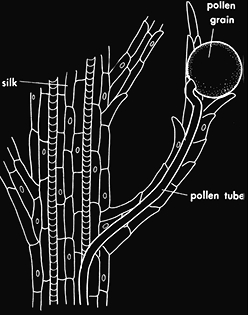
The post-pollination scuttlebutt overheard in coffee shops throughout Indiana during late summer often revolves around the potential for severe stress that might reduce kernel set or kernel size in neighborhood cornfields.


The post-pollination scuttlebutt overheard in coffee shops throughout Indiana during late summer often revolves around the potential for severe stress that might reduce kernel set or kernel size in neighborhood cornfields.

White-tailed deer (Odocoileus virginianus) are among the common mammal pests of field corn in Indiana.

The “notched leaf edge” symptom in corn is a curious genetic leaf “disorder” that appears in certain hybrid families during periods of rapid development.

The grain fill period begins with successful pollination and initiation of kernel development, and ends approximately 60 days later when the kernels are physiologically mature. During grain fill, the developing kernels are the primary sink for concurrent photosynthate produced by the corn plant. What this means is that the photosynthate demands of the developing kernels will take precedence over that of much of the rest of the plant.

Field corn in Indiana typically enters the critical flowering stages of pollen shed and silk emergence sometime between late June to late July. Success or failure during this period of the corn plant’s life greatly influences the potential grain yield at harvest time.

The silks that emerge from the ear shoot are the functional stigmas of the female flowers of a corn plant. Each silk connects to an individual ovule (potential kernel). A given silk must be pollinated in order for the ovule to be fertilized and develop into a kernel. Up to 1000 ovules typically form per ear, even though typically only 400 to 600 actual kernels per ear survive until harvest.

Early season dry periods are historically not that common for the Eastern Corn Belt of the U.S.

The rest of the story… Severe above-ground DAMAGE to V1-V2 CORN from FROST/FREEZE on May 9.

The consequences of flooding, ponding, and saturated soils on young corn depend heavily on the duration of the stress and temperatures.
On the latest Purdue Crop Chat podcast found here and on iTunes, Purdue Extension Corn Specialist Dr. Bob Nielsen and Soybean Specialist Dr. Shaun Casteel talk about the impact of the frost event over the weekend and if replanting will be necessary.
© 2024 Purdue University | An equal access/equal opportunity university | Copyright Complaints | Maintained by Pest&Crop newsletter
If you have trouble accessing this page because of a disability, please contact Pest&Crop newsletter at luck@purdue.edu.